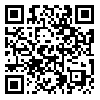Volume 25, Issue 1 (April 2018)
J Birjand Univ Med Sci. 2018, 25(1): 52-61 |
Back to browse issues page
1- Instructor of Nursing, Faculty of Nursing and Midwifery, Birjand University of Medical Sciences, Birjand, Iran
2- Assistant Professor of Nursing, Faculty of Nursing and Midwifery, Birjand University of Medical Sciences, Birjand, Iran.
3- Instructor of Nursing, Faculty of Nursing and Midwifery, Birjand University of Medical Sciences, Birjand, Iran.
4- Instructor of Nursing, Faculty of Nursing and Midwifery, Birjand University of Medical Sciences, Birjand, Iran. , hosseini.msn@gmail.com
2- Assistant Professor of Nursing, Faculty of Nursing and Midwifery, Birjand University of Medical Sciences, Birjand, Iran.
3- Instructor of Nursing, Faculty of Nursing and Midwifery, Birjand University of Medical Sciences, Birjand, Iran.
4- Instructor of Nursing, Faculty of Nursing and Midwifery, Birjand University of Medical Sciences, Birjand, Iran. , hosseini.msn@gmail.com
Abstract: (8307 Views)
Background and Aim: Self concept is one of the important aspects of social development that each individual uses for self description. Physical self concept includes the persons’ attitude toward their body dimensions. Lack of proper perception of the physical self concept has been linked to physical, mental, and social disorders. This study was aimed to investigate the relationship between physical activities with physical self concept among male medical students in Birjand University of Medical Sciences in 2016.
Materials and Methods: In this descriptive- analytical study, study scale was distributed among all of the male medical students. A questionnaire including of demographic data and physical activity as well as the Physical Self Description Questionnaire (PSDQ: Marsh, 1996) was completed by participants. by SPSS 19 software using statistical method, And analytical (Mann-Whitney and Kruskal-Wallis tests) were analyzed.
Results: A total of 452 students with the mean age of 22.11± 2.85 years participated. 350 (77.4%) students don't have physical activity, 76 (16.8%) did regular heavy athletic performance and 26 (5.8%) did regular light sport activity. Results showed a significant relationship between physical self-concept and athletic performance (p=0.02).
Conclusion: According to the results of this study, it was found that athletic performance improves physical self-esteem and self-esteem of students. Therefore, health system policy makers can promote the necessary facilities for expanding the culture of sports activities and also create an environment with sufficient facilities in the university.
Materials and Methods: In this descriptive- analytical study, study scale was distributed among all of the male medical students. A questionnaire including of demographic data and physical activity as well as the Physical Self Description Questionnaire (PSDQ: Marsh, 1996) was completed by participants. by SPSS 19 software using statistical method, And analytical (Mann-Whitney and Kruskal-Wallis tests) were analyzed.
Results: A total of 452 students with the mean age of 22.11± 2.85 years participated. 350 (77.4%) students don't have physical activity, 76 (16.8%) did regular heavy athletic performance and 26 (5.8%) did regular light sport activity. Results showed a significant relationship between physical self-concept and athletic performance (p=0.02).
Conclusion: According to the results of this study, it was found that athletic performance improves physical self-esteem and self-esteem of students. Therefore, health system policy makers can promote the necessary facilities for expanding the culture of sports activities and also create an environment with sufficient facilities in the university.
Type of Study: Original Article |
Subject:
Clinical Psychology
Received: 2017/09/13 | Accepted: 2018/02/23 | ePublished ahead of print: 2018/04/14 | ePublished: 2018/04/5
Received: 2017/09/13 | Accepted: 2018/02/23 | ePublished ahead of print: 2018/04/14 | ePublished: 2018/04/5
| Rights and permissions | |
 |
This work is licensed under a Creative Commons Attribution-NonCommercial 4.0 International License. |
